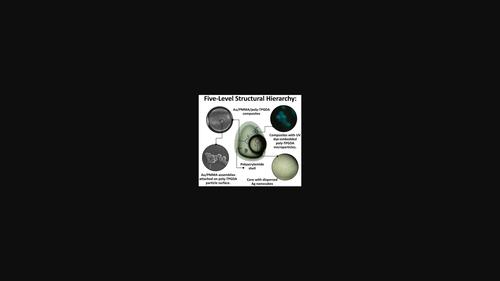五级结构层次:含有嵌套的分散金属和聚合物微粒子和纳米粒子的核壳微粒子的微流控合成
IF 3
4区 材料科学
Q3 CHEMISTRY, PHYSICAL
引用次数: 0
摘要
本研究提出了一种分层设计概念的发展,用于合成具有多达五个组织层次的多尺度聚合物颗粒。通过双同轴毛细管微流控装置原位光聚合,合成了含有嵌套的分散金属和聚合物微纳米颗粒的核壳微颗粒。通过优化载体相、壳相和芯相的流速来控制颗粒大小,从而得到稳定的核-壳相,并在壳基体中具有良好分散的三层复合材料。这些核壳颗粒的坚固性和可逆性通过干燥和再膨胀的五个循环来证明,表明核壳颗粒的大小和结构保持不变。此外,还测试了染料分子在壳基质中的渗透性和迁移率,发现不同分子量的染料具有不同的渗透时间。这项研究强调了微流体作为控制和精确合成复杂结构材料的强大工具的潜力,并展示了这些核壳颗粒在传感应用中的多功能性和潜力,如颗粒基表面增强拉曼散射(SERS)。本文章由计算机程序翻译,如有差异,请以英文原文为准。

Five‐Level Structural Hierarchy: Microfluidically Supported Synthesis of Core–Shell Microparticles Containing Nested Set of Dispersed Metal and Polymer Micro and Nanoparticles
This study presents the development of a hierarchical design concept for the synthesis of multi‐scale polymer particles with up to five levels of organization. The synthesis of core–shell microparticles containing nested sets of dispersed metal and polymer micro‐ and nanoparticles is achieved through in situ photopolymerization using a double co‐axial capillaries microfluidic device. The flow rates of the carrier, shell, and core phases are optimized to control particle size and result in stable core–shell particles with well‐dispersed three‐level composites in the shell matrix. The robustness and reversibility of these core–shell particles are demonstrated through five cycles of drying and re‐swelling, showing that the size and structure of core–shell particles remain unchanged. Additionally, the permeability and mobility of dye molecules within the shell matrix are tested and showed that different molecular weight dyes have different penetration times. This study highlights the potential of microfluidics as a powerful tool for the controlled and precise synthesis of complex structured materials and demonstrates the versatility and potential of these core–shell particles for sensing applications as particle‐based surface‐enhanced Raman scattering (SERS).
求助全文
通过发布文献求助,成功后即可免费获取论文全文。
去求助
来源期刊

Particle & Particle Systems Characterization
工程技术-材料科学:表征与测试
CiteScore
5.50
自引率
0.00%
发文量
114
审稿时长
3.0 months
期刊介绍:
Particle & Particle Systems Characterization is an international, peer-reviewed, interdisciplinary journal focusing on all aspects of particle research. The journal joined the Advanced Materials family of journals in 2013. Particle has an impact factor of 4.194 (2018 Journal Impact Factor, Journal Citation Reports (Clarivate Analytics, 2019)).
Topics covered include the synthesis, characterization, and application of particles in a variety of systems and devices.
Particle covers nanotubes, fullerenes, micelles and alloy clusters, organic and inorganic materials, polymers, quantum dots, 2D materials, proteins, and other molecular biological systems.
Particle Systems include those in biomedicine, catalysis, energy-storage materials, environmental science, micro/nano-electromechanical systems, micro/nano-fluidics, molecular electronics, photonics, sensing, and others.
Characterization methods include microscopy, spectroscopy, electrochemical, diffraction, magnetic, and scattering techniques.
 求助内容:
求助内容: 应助结果提醒方式:
应助结果提醒方式:


